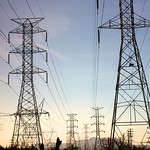Today, the Sabin Center filed two amicus briefs—one on behalf of the National League of Cities and the U.S. Conference of Mayors, and a second on behalf of experts in carbon capture and storage (CCS) science and technology—in support of the U.S. Environmental Protection Agency (EPA) in West Virginia v. EPA. Several states and industry groups are challenging EPA’s 2024 rules which set greenhouse gas emissions limits for certain fossil fuel power plants nationwide (referred to here as the Power Plant Rules). This case will have a major impact on how and when power plants must reduce their greenhouse gas emissions. EPA projects that the rules will significantly reduce greenhouse gas emissions from the country’s largest stationary sources—power plants—by 1.38 billion metric tons of carbon pollution through 2047.
The Sabin Center’s two briefs highlight (1) the crucial role that local governments play in responding to the climate crisis and how EPA’s Power Plant Rules support local climate action; and (2) the maturity of CCS technology which will allow EPA’s standards to be met at power plants.
This blog post begins with an overview of EPA’s authority to regulate greenhouse gas emissions from fossil fuel power plants and the Power Plant Rules. That is followed by a summary of the two briefs filed by the Sabin Center.
EPA’s 2024 Power Plant Rules
 EPA is required to regulate power plant emissions under Section 111 of the Clean Air Act. Section 111 requires EPA to establish standards of performance for certain categories of stationary sources that “cause[ ], or contribute[] significantly to, air pollution which may reasonably be anticipated to endanger public health or welfare.” In 2007, the Supreme Court held in Massachusetts v. EPA that carbon dioxide and other greenhouse gases fall within the Clean Air Act’s capacious definition of “air pollutant.” Subsequently, in 2009, EPA determined that greenhouse gas pollution threatens Americans’ health and welfare by leading to long-lasting changes in our climate that can have a range of negative effects on human health and the environment. Since then, EPA has adopted standards to control greenhouse gas emissions from a variety of facilities, including power plants. The Supreme Court has repeatedly upheld EPA’s authority “to regulate carbon-dioxide emissions from powerplants” (see, for example, Am. Elec. Power Co. v. Connecticut, 564 U.S. 410, 426 (2011)).
EPA is required to regulate power plant emissions under Section 111 of the Clean Air Act. Section 111 requires EPA to establish standards of performance for certain categories of stationary sources that “cause[ ], or contribute[] significantly to, air pollution which may reasonably be anticipated to endanger public health or welfare.” In 2007, the Supreme Court held in Massachusetts v. EPA that carbon dioxide and other greenhouse gases fall within the Clean Air Act’s capacious definition of “air pollutant.” Subsequently, in 2009, EPA determined that greenhouse gas pollution threatens Americans’ health and welfare by leading to long-lasting changes in our climate that can have a range of negative effects on human health and the environment. Since then, EPA has adopted standards to control greenhouse gas emissions from a variety of facilities, including power plants. The Supreme Court has repeatedly upheld EPA’s authority “to regulate carbon-dioxide emissions from powerplants” (see, for example, Am. Elec. Power Co. v. Connecticut, 564 U.S. 410, 426 (2011)).
In establishing performance standards, EPA must determine the emissions reductions that are achievable using the “best system of emission reduction” (BSER) that has been “adequately demonstrated,” taking into account the cost of the reductions, non-air quality health and environmental impacts, and energy requirements. Performance standards do not mandate the use of any particular technology. EPA sets an emissions cap based on the emissions reductions that can be achieved through the BSER, but power plants are free to choose how they will meet that emissions cap.
The Power Plant Rules consist of three main agency actions. First, they repeal the Trump-era Affordable Clean Energy Rule. Second, the rules prescribe performance standards for existing coal- and natural gas-fired power plants. Finally, the rules prescribe performance standards for new and modified natural gas-fired power plants.
EPA established different performance standards for different sub-categories of fossil fuel power plants based on plant longevity and capacity. A summary of the BSER for each sub-category can be found here. The BSER that will likely be at the center of litigation is a CCS system that captures 90% of carbon dioxide emissions. This applies to two sub-categories of plants: (1) existing coal-fired plants that intend to operate past January 1, 2039 and (2) new base load natural gas-fired plants.
The Petitioners in this case filed for review in the U.S. Court of Appeals, D.C. Circuit on May 9, 2024, contending that the final rule “exceeds [EPA’s] statutory authority, and otherwise is arbitrary and capricious, an abuse of discretion, and not in accordance with law.” On May 13, 2024, the Petitioners filed a motion to stay the rule during the pendency of the litigation, which a three-judge panel of the D.C. Circuit unanimously denied in July. On October 16, 2024, the Supreme Court also denied an emergency stay request from the Petitioners, meaning that the Power Plant Rules will remain in effect during litigation.
Amicus Brief on Behalf of National League of Cities and the U.S. Conference of Mayors
The Sabin Center’s amicus brief, filed on behalf of the National League of Cities (NLC) and the U.S. Conference of Mayors (USCM), explains that cities often experience the most severe impacts of climate change and highlights the leading role they play in climate mitigation and adaptation efforts. We also argue that the Power Plant Rules fall well within EPA’s authority to regulate power plants and that the rules reflect the cooperative federalism that underlies Section 111 of the Clean Air Act.
First, the Sabin Center describes how cities of all sizes and in every region of the country are disproportionately harmed by the increasingly severe impacts of climate change, and that they must also foot the bill for ever-rising costs associated with those impacts. From immense hurricane storm surges, to rising sea levels and intense heat waves, the health and well-being of cities and their residents are threatened by climate impacts that cost cities billions of dollars each year.
Next, we explore the ways in which cities of all sizes lead the response to climate change through mitigation measures that reduce greenhouse gas emissions and creative adaptation solutions that protect urban residents from heat and other weather extremes. Hundreds of cities, large and small, have set ambitious greenhouse gas reduction goals and crafted climate action plans that set forth actionable, equitable decarbonization pathways for their communities. Local governments’ mitigation and adaptation efforts include electrifying their fleets and installing electric vehicle charging infrastructure, deploying renewable energy resources, mandating or incentivizing energy-efficiency retrofits for buildings, upgrading their stormwater management systems, creating resources to respond to extreme heat events, increasing the urban tree canopy, and expanding green infrastructure programs, among many others.
Finally, the Sabin Center contends that the Power Plant Rules fall neatly within EPA’s authority to regulate greenhouse gas emissions from stationary sources. In 2022’s West Virginia v. EPA, the Supreme Court imparted a clear directive to EPA about how the agency may regulate greenhouse gas emissions; the agency is generally “limited to ensuring the efficient pollution performance of each individual regulated source.” In this case, EPA is doing exactly what the Clean Air Act directs it to do: regulating greenhouse gas emissions from individual sources using a technology-based approach. The Power Plant Rules also preserve the cooperative federalism framework within which EPA regulates GHG emissions. Cities rely on strong federal regulation for sources outside their jurisdiction. Without that regulation, cities’ adaptation budgets will be further stressed (or their adaptation investments will prove inadequate despite considerable price tags); their mitigation measures will fail to achieve maximum greenhouse gas reductions; and local governments’ bills for responding to climate disasters will continue to mount.
Amicus Brief on Behalf of CCS Science and Technology Experts
The Sabin Center also filed an amicus brief on behalf of six experts in CCS science and technology, hailing from major research institutions across the country. The purpose of the brief is to lend CCS scientists’ and engineers’ expertise to the court as it evaluates EPA’s BSER and performance standards.
A central issue in the case is whether EPA was right to conclude that CCS with a 90% carbon dioxide capture rate reflects the BSER for certain fossil fuel power plants. The central contention of the parties challenging EPA’s Power Plant Rules are that the agency exceeded its statutory authority under the Clean Air Act because it set performance standards based on a BSER that is not “adequately demonstrated.” The Sabin Center’s brief supports EPA in rebutting that allegation by providing scientific evidence that CCS systems with a 90% carbon dioxide capture rate are feasible, reliable, and have been demonstrated by real-world application in multiple commercial scale projects.
Drawing on the CCS experts’ knowledge, the Sabin Center’s brief explains the history of development of CCS technologies and highlights the many commercial-scale, integrated CCS facilities that have been deployed at power plants world-wide. It focuses, in particular, on recent technological advances in CCS systems with 90% carbon dioxidecapture, highlighting projects such as Petra Nova (Texas), Boundary Dam Unit 3 (Canada), Plant Barry (Alabama), and others which demonstrate that the technology is viable at commercial-scale. The brief also explains how these projects set the stage for rapid deployment of the existing technologies at a wide range of facilities over the next few years. Finally, the brief provides evidence that past experience in implementing 90% capture technology at power plants has, and will continue to, yield significant cost reductions, making EPA standards easier to achieve in the future.
Because one of the central issues in the case is the sufficiency of CCS technology, it is critical that the voices of experts in CCS science and technology are heard on the matter. The experts can help to inform the court about the feasibility and cost-effectiveness of CCS systems.
Conclusion
As climate impacts intensify, EPA’s ability to implement effective regulations will be a key determinant of the nation’s climate trajectory. The Sabin Center’s amicus briefs give the court an opportunity to hear important legal and scientific context from U.S. cities and CCS scientists, both of which support EPA’s Power Plant Rules. For cities’ parts, robust power sector regulation consistent with EPA’s Section 111 authority is critical to protecting city residents nationwide, to lessening the financial burdens cities face in responding to the climate crisis, and to bolstering cities’ own greenhouse gas mitigation efforts. As the CCS scientists explain, the performance standards adopted by EPA are informed by proven technology that has already been successfully used to reduce carbon dioxide emissions from power plants and can be rapidly deployed across the sector in response to the new rules, thus delivering major climate benefits.




